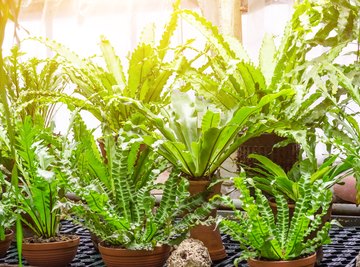
Plants cannot survive in total darkness. All plants, with the exception of a few that live on other organisms, use a process called photosynthesis to obtain the energy they need. The vast majority of plants are autotrophs—they are self-feeding and require sunlight to survive. They produce energy in specialized organelles inside their cells called chloroplasts. In most plants, chloroplasts are concentrated in the leaves.
Daily periods of darkness have a role to play in the growth of plants, as all plants have a cellular biological clock called a circadian rhythm: Light and the absence of light trigger different processes in plant metabolism, growth and behavior.
TL;DR (Too Long; Didn't Read)
The vast majority of plants depend on light to grow; they cannot live in complete darkness. However, the cycles and lengths of the day play an important role in plant growth.
Nonphotosynthesizing Plants: Heterotrophs
Plants that live on other organisms are the exception rather than the rule. These plants are heterotrophs and do not have chloroplasts. Therefore, they do not create the materials they need to use from the sun. In theory, this means these plants could grow in complete darkness. They are often found in low-light conditions such as those found on a forest floor.
It was formerly thought that some plants could survive on decaying matter alone, and these plants were called saprophytes. However, it has been discovered that all of these plants have a symbiotic or parasitic relationship with fungi and are therefore more properly called myco-heterotrophs. Indian pipes, for example, obtain their energy from fungi, which in turn obtain their energy from tree roots. Other heterotropic plants are parasites directly on plants. Squawroot is a parasite on the roots of the red oak, for example.
Although these plants do not photosynthesize themselves, they are ultimately dependent upon plants that do photosynthesize for all of their energy. So while they themselves can grow in darkness, their energy-producing host organisms cannot.
Photosynthesizing Plants: Autotrophs
The vast majority of species in the plant kingdom produce the fuel they need from the sun with inputs of minerals and matter from air, soil and water. The amount of sunlight that plants need, however, is highly variable.
Plants with large broad leaves tend to be from warm and wet tropical areas with steady, nonfluctuating year-round overhead sun. They may also be plants that exist on the forest floor of temperate regions where they grow large leaves to catch as much solar radiation as possible in low-light conditions.
Plants with small leaves tend to be from cooler or drier biomes. Temperate zone trees lose their leaves every year as the daylight hours get shorter, so their leaves are smaller to conserve energy. With the abundant sunlight in the desert, the "leaves" on cacti take the form of needles that protect the precious water inside from consumers in the environment. Cacti do photosynthesize, but most of this activity takes place in the stems instead of the needles.
In temperate biomes, the amount of sunlight can be extreme, which results in some extreme growth patterns in domestic plants. Despite the cooler temperatures, Alaska often produces record-breaking pumpkins and cabbages during the short growing season owing to the extremely long midnight sun days of summer.
Plant Metabolism and Circadian Rhythms
While all plants need sunlight in some capacity to survive, they have metabolic processes that continue in darkness. One example of a light-independent process is the Calvin cycle, whereby carbon is captured and converted into stored energy using energy that is stored from other photosynthetic reactions during the day. Another is respiration, where oxygen is combined with stored food to make it usable. Plants usually produce oxygen during the day due to photosynthetic reactions and use oxygen at night due to respiration.
Owing to their internal circadian rhythms, while it's dark, plants anticipate the coming of dawn and prepare for it on a cellular level before their chloroplasts are stimulated by light.
In short, darkness plays a significant role in plant growth, influencing chloroplast distribution, leaf shape, growth patterns and the duration of daily cycles.
References
- Encyclopedia Britannica: Parasitic Plant
- ScienceDirect: Plants Parasitic on Fungi: Unearthing the Fungi in Myco-Heterotrophs and Debunking the ‘Saprophytic’ Plant Myth
- National Park Service: Cacti / Desert Succulents
- Scitable: Plant Cells, Chloroplasts, and Cell Walls
- University of Michigan: A Primer on Photosynthesis and the Functioning of Cells
- LiveScience: In the Dark, Plants Prepare for Light
About the Author
Lynsey is a science writer, specializing in agriculture, horticulture and sustainability topics. She has an undergraduate degree in Anthropology and is working on a Master's in Science Communication.
